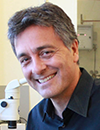|
Day 2 of the Conference [All Times are Pacific Times] |
| |
|
Session Title: Emerging Themes in Microfluidics in 2020 |
| |
09:00 |  Point-of-Care Testing and COVID-19: One-Shot or Long-Term Opportunity? Point-of-Care Testing and COVID-19: One-Shot or Long-Term Opportunity?
Sébastien Clerc, Technology & Market Analyst, Microfluidics & Medical Technologies, Yole Développement
Abstract: The past few months have seen a new biological threat, the COVID-19 infection, caused by the SARS-CoV-2 virus, reshape the entire diagnostics ecosystem. Numerous companies rapidly started developing tests to detect the pathogen. But is point-of-care testing the real solution to identify early cases and stop the pandemic? Will there be a change in the use cases in the near future, like testing at the workplace, at the airport or in public transportation or public places? In this talk, Sébastien Clerc will share Yole’s vision of the point-of-care landscape and how the pandemic has impacted it.
|
09:30 |  Innovative Methods in the Characterization of Microfluidic Devices for High Volume Manufacturing Innovative Methods in the Characterization of Microfluidic Devices for High Volume Manufacturing
Magdalena Schimke, Business Development and Sales, Single Cell Diagnostics, STRATEC Consumables GmbH
The range of applications for microfluidic devices is constantly expanding and so are the challenges for manufacturing. There is always exitement for the development of new manufacturing methods, but the importance of new analytical methods is often underestimated by contract manufacturers. Here we present our latest advances in the metrology for injection molded microfluidic devices. Especially in the development of nm-sized fluidic channels, µm-sized fluidic channels with nm-precision, and devices with a combination of inorganic and organic coatings we came across challenges that required new analytical methods. The questions range from a simple "how deep is a microfluidic channel after bonding", to "what manufacturing process has the biggest impact on channel roughness - from Mastering to the finished device". To answer these questions, we had to find new ways to characterize the different processes along the manufacturing chain. The analytical methods that we developed opened up the door to new types of devices, or made it possible to mass manufacture new high complexity consumables.
|
10:00 |  | Keynote Presentation Optofluidic Systems For On-Chip Molecular Diagnostics
Holger Schmidt, Narinder Kapany Professor of Electrical Engineering, University of California-Santa Cruz, United States of America
Optofluidic devices have emerged as the basis for ultra-sensitive, amplification-free analysis of single molecules. We will describe the core features and capabilities of this approach and discuss recent advances in the areas of integration of multiple functions on a single chip, optical detection and analysis with maximized efficiency, and representative examples such as multiplex detection of single antibiotic resistant bacteria and SARS-CoV-2 detection. |
|
10:30 |  | Keynote Presentation Microfluidic-based Diagnostic Approaches for COVID-19
Dino Di Carlo, Armond and Elena Hairapetian Chair in Engineering and Medicine, Professor and Vice Chair of Bioengineering, University of California-Los Angeles, United States of America
Microfluidic technologies have laid a foundation for a number of diagnostic solutions that are especially relevant during the COVID-19 pandemic. I will discuss technological platforms being applied to rapidly detect the SARS-CoV-2 virus, characterize antibodies produced by individuals in response to infection, and triage patients based on detection of abnormal host immune activation. Integration of microfluidic and machine learning approaches enable these tests to have rapid turnaround times which are critical for clinical scenarios involving diagnosing infected individuals at the point-of-care, broadly screening for immunity / vaccination effectiveness, and triaging patients entering the emergency room based on the amount of care needed. |
|
14:30 |  | Keynote Presentation Plastic-based Nanofluidic Sensor for the Detection of Rare Nucleic Acids and Determining Their Sequence Variations from Liquid Biopsy Markers
Steve Soper, Foundation Distinguished Professor, Director, Center of BioModular Multi-Scale System for Precision Medicine, The University of Kansas, United States of America
Liquid biopsy markers (circulating tumor cells, CTCs; extracellular vesicles, EVs; and cell free DNA, cfDNA) are becoming extremely popular to manage a variety of cancer-related diseases due to the minimally invasive nature of their acquisition. However, the challenge with liquid biopsy markers is their rarity; for example, it is not uncommon to secure 1-100 CTCs per mL of whole blood supplying about 6-600 pg of genomic DNA. Because platforms like next generation sequencing require >30 ng of input DNA, significant amounts of amplification of the input are required that can generate a biased representation of the genome. To mitigate this issue, we have produced a mixed-scale nanofluidic sensor featuring a baffle area, high surface area pillar arrays, and nanometer flight tubes. The pixel arrays can perform solid-phase ligase detection reactions (spLDRs) to score the presence of DNA mutations found in a diseased patient even when the mass of the marker is low (<1 ng), but does not require PCR amplification for the analysis. The spLDR can also expression profile mRNAs following reverse transcription. Successfully formed spLDR products are identified using a molecular-dependent time-of-flight (TOF) through a polymer nanofluidic channel flanked by two in-plane nanopores. Simulations (COMSOL) were used to guide the design and fabrication of the nanofluidic sensor to determine the loading efficiency and transport patterns of spLDR products from the pillar array into the flight tubes by evaluating operational parameters when using either hydrodynamic or electrokinetic flow. The nanofluidic sensor was fabricated from a Si master patterned using a combination of focused ion beam (FIB) milling and photolithography with inductively coupled plasma reactive ion etching. The Si master was used to produce resin stamps that were then used to transfer the relevant structures to a plastic via thermal nanoimprint lithography (NIL). The operational features of the device will be presented as well as detecting point mutations in KRAS genes from CTCs’ genomic DNA as well as mRNA expression profiling. |
|
15:00 |  | Keynote Presentation Microfluidic Cell Engineering for Precision Therapy
Abraham Lee, Professor, University of California Irvine, United States of America
Precision medicine is the paradigm to develop treatments for patients based on molecular-targets that are effective in vivo when administered. That is, one must not only be able to identify molecular and cellular targets that are the source of disease but also understand how these targets behave in the body based on physiological principles. Recent developments in microfluidics have contributed to burgeoning precision medicine fields such as liquid biopsy, immunotherapy, single cell analysis, genotyping and gene sequencing, and microphysiological systems. A specific focus of my talk would be on microfluidic devices for engineering cells for developing targeted cell therapies and immunotherapies. These microfluidic technologies have the potential to close the loop from detection to diagnosis, to therapy. |
|
15:30 |  Modeling and Simulation of Microfluidic Devices Modeling and Simulation of Microfluidic Devices
Matthew Hancock, Managing Engineer, Veryst Engineering, LLC
Modeling and simulation are key components of the engineering development process, providing a rational, systematic method to engineer and optimize products and dramatically accelerate the development cycle over a pure intuition-driven, empirical testing approach. Modeling and simulation help to identify key parameters related to product performance (“what to try”) as well as insignificant parameters or conditions related to poor outcomes (“what not to try”). For microfluidic devices, modeling and simulation can inform the design and integration of common components such as mixers, micropumps, manifolds, and channel networks. Modeling and simulation may also be used to estimate a range of processes occurring within the fluid bulk and near cells, including shear stresses, transport of nutrients and waste, chemical reactions, heat transfer, and surface tension & wetting effects. I will discuss how an array of modeling tools such as scaling arguments, analytical formulas, and finite element simulations may be leveraged to address these microfluidic device development issues. I will also work through a few examples in detail.
|
16:00 |  Plastic Design Corporation—American Production of Microfluidic Systems for Life Science Applications Plastic Design Corporation—American Production of Microfluidic Systems for Life Science Applications
Chris Becker, Sales and Marketing, Plastic Design Corporation (PDC)
PDC sets itself apart from other companies in the field of injection-molded healthcare consumables in that it is an American manufacturer, does all of its tooling in-house, and manufactures exclusively in cleanroom conditions. Nearly 30 years’ experience in the production of critical lab-ware and microfluidic components for the Life Sciences have earned PDC a justifiably excellent reputation as a reliable and progressive partner for biotech and pharmaceutical companies.
|
16:30 |  | Keynote Presentation Free-Surface Microfluidics and SERS for High Performance Sample Capture and Analysis
Carl Meinhart, Professor, University of California-Santa Barbara, United States of America
Nearly all microfluidic devices to date consist of some type of fully-enclosed microfluidic channel. The concept of ‘free-surface’ microfluidics has been pioneered at UCSB during the past several years, where at least one surface of the microchannel is exposed to the surrounding air. Surface tension is a dominating force at the micron scale, which can be used to control effectively fluid motion. There are a number of distinct advantages to the free surface microfluidic architecture. For example, the free surface provides a highly effective mechanism for capturing certain low-density vapor molecules. This mechanism is a key component (in combination with surface-enhanced Raman spectroscopy, i.e. SERS) of a novel explosives vapor detection platform, which is capable of sub part-per-billion sensitivity with high specificity. |
|
17:00 | Extracellular Vesicles: Challenges and Opportunities for Single Particle Analysis
John Nolan, CEO, Cellarcus Biosciences, Inc., United States of America
Extracellular vesicles (EVs) are released by all cells and represent a rich source of potential biomarkers. However, EVs in biofluids such as plasma are extremely heterogeneous, and discriminating informative signal from obscuring noise limits the usefulness of bulk analysis methods such as PCR or Western blot. Single vesicle analysis has the potential to resolve this heterogeneity, but small size and low analyte abundance challenges conventional single particle analysis approaches. Overcoming these challenges will require new measurement tools, including instruments, reagents, and standards that can be integrated into assays with improved sensitivity, specificity, and reproducibility. I will review the state of EV analysis, and highlight new insights provided by high resolution single vesicle flow cytometry (vFC) into the compositional and functional diversity of EVs. |
17:30 | On-chip Surface Acoustic Wave and Micropipette Aspiration Techniques to Assess Cell Elastic Properties
Yanqi Wu, Researcher, Department of Biomedical Engineering, The University of Melbourne, Australia
Cells in vivo mechanically interact with the local microenvironment, stressing the important role of cell mechanical properties in cellular behaviours. We built a phase-modulated surface acoustic wave microfluidic device measuring cellular compressibility (or bulk modulus) and a microfluidic micropipette-aspiration device measuring cellular Young’s modulus, facilitating the investigations of cellular elastic properties and cytoskeletal mechanics. |
18:00 | Close of Day 2 of the Conference |

















